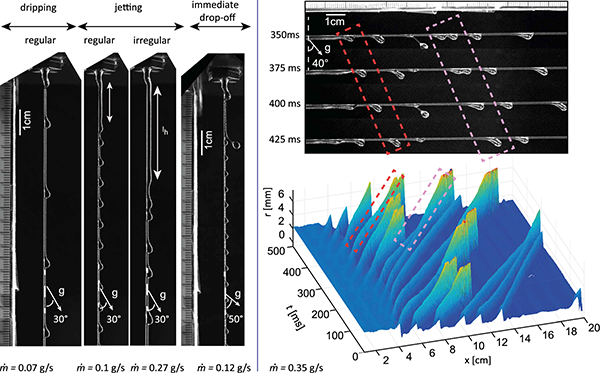EPJ ST Highlight - Dynamics of fluid flow on (and off) inclined fibres
- Details
- Published on 10 February 2025

An empirical analysis of oil flowing down an inclined fibre has suggested how the structure and dynamics of droplet formation and drop-off is affected by the multiple forces involved in this deceptively simple phenomenon.
The commonplace phenomenon of liquid drops falling from a surface is, perhaps surprisingly, not yet fully understood by scientists. Understanding the complex interactions between the forces involved here would be helpful in industry, where structured packings in cooling towers must be designed to encourage droplet formation in fluid flow but coatings mixed to maintain a pristine, smooth surface. Furthermore, the design of meshes used to harvest clean water from fog or dew, where this is limited, relies on an understanding of how the water condenses on the fibres and drops into collection tanks.
Atefeh Pour Karimi, a PhD student at the Institute of Heat and Mass Transfer, Aachen University, Germany and her supervisors and collaborators have analysed the dynamics of this type of flow in detail and published their findings in the journal EPJ Special Topics (EPJ ST).
“Droplet formation in a flowing film is controlled by an interplay of gravity, surface tension, inertia and viscous forces”, explains Pour Karimi. “Mathematically, this behaviour can be described as chaotic, with small variations in parameters leading to unpredictable behaviour”. She and her co-workers studied the process using oil flowing down inclined fibres under the influence of gravity, and varying the film thickness and angle of inclination.
The oil flows down the fibres as a flat film before collecting into beads or droplets. These will either remain stable on the fibres, collide and coalesce or simply grow until they are large enough to detach and drop off.
Pour Karimi and her colleagues defined a new angle ratio, Φ, to characterise the droplet shape and used this to predict accurately how each would behave. “We suggest that the value of Φ, and therefore the behaviour of each droplet, is determined by the dominant force influencing its formation”, she adds. “We now hope to confirm this speculation by using mathematical models derived from theory.”
Pour Karimi, A., Hormann, B., Askarizadeh, H. et al. Drop-off characteristics of film flow on inclined fibers. Eur. Phys. J. Spec. Top. (2025). https://doi.org/10.1140/epjs/s11734-024-01457-z




